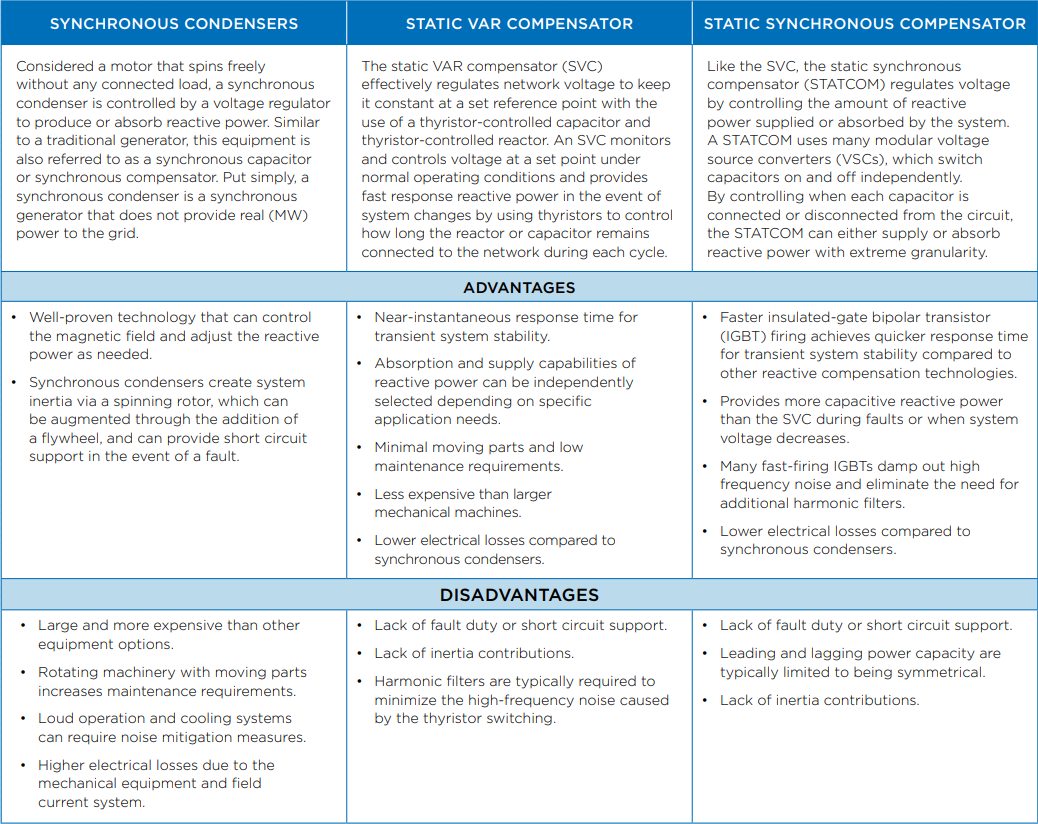DEVELOPING GRID STABILITY SOLUTIONS
For offshore wind operations, additional frequency, voltage and short circuit current capability are sometimes required to support the stability of the grid. Several systems can be put in place to address grid stability needs.
REACTIVE POWER
Electrical systems in the U.S. operate at 60 hertz (Hz), meaning the alternating voltage and current go through a cycle of positive and negative polarity approximately 60 times per second. Devices connected to this power grid require electric and magnetic fields to operate and transmission lines, transformers, motors, etc., all need electrical current to produce these fields. The power necessary to provide the currents for these fields is called reactive power and is measured in volt-ampere-reactive (VAR). Reactive power is stored in electric or magnetic fields, and this power is absorbed and resupplied back to the system every cycle. Reactive power results in the voltage and current waveforms being out of phase from each other as these electric and magnetic fields charge and discharge.
Reactive power is produced by devices that either inherently, through fundamental physical properties, create a phase angle difference, or through devices that can control the phase angle difference between the current and the voltage. Most devices connected to the grid, such as motors and compressors, consume reactive power. A surplus of reactive power will result in an increased system voltage, and a shortage of reactive power will result in a decreased system voltage. System voltages need to remain within a certain operating range, which varies from region to region but generally must be within 0.95 pu to 1.05 pu.
Passive devices that produce or consume reactive power include capacitors and reactors, respectively. Capacitors serve as sources for reactive power and reactors serve as consumers of reactive power. Because of the nature of reactive power and its mathematical connection to phase angle difference, in terms of stability, both can be viewed as sources of reactive power. In this view, capacitors are sources of “leading” reactive power, where the current waveform peaks before (or leads) the voltage waveform. Reactors are sources of “lagging” reactive power, where the current waveform peaks after (or lags) the voltage waveform.
Active devices would include synchronous machines such as generators, large synchronous motors and synchronous condensers, all of which control the phase angle difference between the voltage and current by varying the strength of the machine field current.
Additionally active devices also include power electronics devices such as static VAR compensators (SVCs) and static synchronous compensators (STATCOMs), collectively known as flexible alternating current transmission system (FACTS) devices. These utilize complex control algorithms and thyristors or insulated-gate bipolar transistors (IGBTs) to control the phase angle difference between the voltage and current.
In offshore wind power systems, the long subsea transmission cables can act as large capacitors. The longer and larger the cables, the greater voltage and current will be out of phase and the more reactive power is consumed. This must be compensated for in the design of offshore wind systems, often with the use of compensation equipment onshore at the site of interconnection to the rest of the grid. Compensating for the reactive power consumption of the offshore cables will allow the cables to operate more efficiently and increase the amount of power that makes it onshore.
SYSTEM INERTIA
Large, rotating masses used in synchronous power generators naturally help to control power system frequency to deliver a balance between generation and demand on the grid. The rotational inertia of a synchronous generator minimizes the rate of change of grid frequency during times of changing conditions. Such inertia keeps power flowing for a period that allows for available response and reaction to faults and outages. Achieving a level of required stability for the grid is not so easy for offshore wind plants.
Inverter-based offshore wind power does not have rotational inertia equipped for energy storage. As offshore wind systems and other inverter-based renewable systems are added to the grid and replace synchronous generation, measures must be taken to reduce the risk of diminished frequency response and control.
.png?width=175&name=azco-white-logo-2020%20(1).png)
